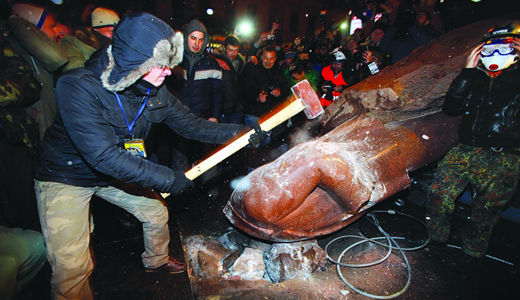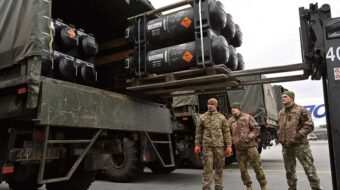
The fighting has more or less died down between the right wing Ukrainian government forces and the militias of the Luhansk and Donetsk regions which have been resisting Kiev’s control. Ukrainian President Petro Poroshenko agreed to a deal which supposedly will allow legislative elections to go ahead while also promising extensive autonomy to the dissident provinces in the East. Moscow and Kiev are now negotiating the basis on which Ukraine can, before the winter starts, be assured of Russian coal and gas supplies. Ukraine’s economy is, at present, a disaster, and facing winter without being able to heat homes and buildings is something that Poroshenko has to avoid at all costs.
But for people in Ukraine, and not only in the East, who don’t agree with the right wing policies of Kiev, the situation is still ominous. The Communist Party of Ukraine is still banned from participating in the national legislature, or RADA, even though it has quite a few elected representatives there. Members of the Communist Party and others seen as not supporting the right are still being subjected to violence and death threats by ultra-right wing hooligans.
And it is almost certain that communists, and perhaps others on the center and left, will not be allowed to run in the elections. This is the goal of the Kiev government’s current “lustration” campaign, by which whole political groups would be prohibited from holding government jobs. The lustration law may turn out to be unconstitutional, but it is a safe bet that the government will find another way to achieve the same objective. It is ironic that “lustration” in Europe is a practice designed to keep Nazis and fascists from controlling government institutions; now it is being used by Ukrainian neo-Nazis and fascists to purge the anti-fascists, including of course communists.
The most extreme right wing activists do not approve of the peace deal with the East and are threatening to march on Kiev to oust Poroshenko and his colleagues.
Meanwhile, these bravos have declared war on statues of Lenin all over the country. Lenin statues and monuments have been removed or destroyed in many communities. On Sept. 28, over the objections of the city’s mayor, a right wing mob tore down one of the tallest Lenin statues, in the city of Kharkiv.
Why did the vandals attack the Lenin statues? Perhaps because Lenin was Russian and a communist? Ironically, Lenin was particularly friendly to the idea of Ukrainian autonomy within the U.S.S.R. and opposed to heavy handed rule over minority nations by the Russian center. His government encouraged a flowering of Ukrainian language and culture (“Ukrainianization”). As a symbol of that, in 1918, when he surely had a lot of other issues to deal with, Lenin had ordered the construction of a statue of Ukraine’s most beloved literary figure, Taras Schevchenko, in St. Petersburg (then Petrograd, later Leningrad, now St.Petersburg again). There are other status of him in Moscow and elsewhere.
Lenin died in January 1924 after a series of strokes left him unable to participate politically for many months. The encouragement of Ukrainian national culture and language was not curtailed until Stalin came into full power.
Lenin had some Jewish ancestry and was a firm enemy of anti-Semitism; possibly the anti-Semitism of the Ukrainian ultra-right could have played a role.
But most probably the destruction of the Lenin statues is meant by ultra right Ukrainian nationalists as a warning to their more left-leaning opponents not to put their heads above the parapet in the future, lest they meet the same fate as the statues-decapitation!
The mayor of Kharkiv promised to restore the statue.
Photo: Protester smashes satue of Lenin after it was knocked down.












Comments